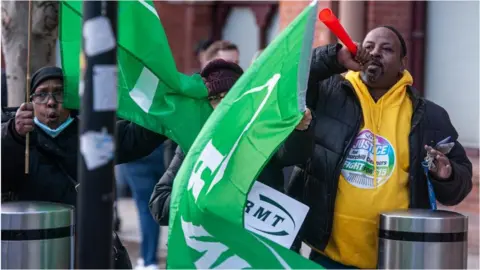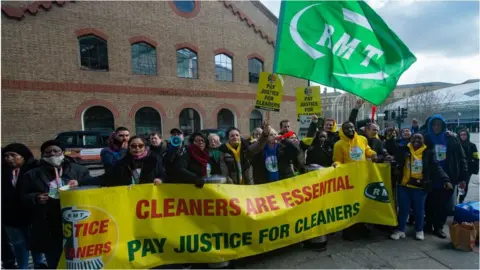Train strike: How much are rail workers paid?
 Getty Images
Getty ImagesTens of thousands of rail workers are planning strike action in December and January in a dispute over pay and redundancies.
The industrial action by members of the RMT union will include a strike starting on Christmas Eve.
The RMT has rejected an offer of 4% this year and next year from the Rail Delivery Group and is urging its members to reject an offer from Network Rail of 5% this year and 4% next year.
There have been lots of claims about how much rail workers are paid. Let's start with the highest figure quoted.
How much are train drivers paid?
In a debate about the strikes in Parliament on 15 June, then Transport Secretary Grant Shapps said: "The median salary for a train driver is £59,000, compared with £31,000 for a nurse and £21,000 for a care worker."
The trouble with using the figure for train drivers in a debate about the RMT strikes is that the drivers are represented by their own union, Aslef, which is not taking part in the national strike.
Aslef, which says it represents 96% of train drivers, held strikes earlier in the year and is still in dispute over pay with the train operating companies.
To work out the median salary, if you put all train drivers in a row in order of their pay, the person in the middle of the row would be earning the median.
Mr Shapps was mostly right on these figures, which came from the Office for National Statistics (ONS).
For 2021, the median salary for train and tram drivers was £59,189 and for nurses it was £31,093.
His figure for care workers was a bit high. The median for care workers and home carers was £16,502 and for senior care workers it was £20,105.
Is the median salary for rail workers £44,000?
Mr Shapps went on to say: "The median salary for the rail sector is £44,000, which is significantly above the median salary in the country."
We asked the Department for Transport (DfT) how it got to this figure and it initially said it had taken the median figures from the ONS for four categories of rail workers, added them up and divided by four:
- Rail travel assistants - £33,310 - includes ticket collectors, guards and information staff
- Rail construction and maintenance operatives - £34,998 - they lay and repair tracks
- Rail transport operatives - £48,750 - includes signallers and drivers' assistants
- Train and tram drivers - £59,189
This wouldn't have produced a median figure and the DfT subsequently got in touch to say they had actually got the figure from the ONS, which had produced a genuine median figure (£43,747) across everybody in those four categories, along with a fifth - workers who build and repair engines and carriages (their median salary was £46,753).
It has also produced a median figure excluding train drivers - who are not involved in the RMT strike - of £36,800.
 Getty Images
Getty ImagesMr Shapps was right that the figure was above the median pay for all employees in the UK, which was £25,971 last year.
Lower figures from the RMT
The RMT union said the figures used by the government were too high because they included train drivers who are almost all represented by a different union and not people like cleaners who are not categorised in the ONS figures as rail workers.
The RMT says 10,000 of its members are cleaners and it is likely that average pay would be reduced by including them.
RMT general secretary Mick Lynch told BBC News on 6 December: "75% of the people in this dispute are paid less than £32,000 a year for working 24/7 shifts."
We asked the union how this had been worked out. It sent us a list dividing 33,000 members involved in the dispute into eight categories of workers, and giving the median salary for each of those categories.
The list shows that three quarters of the workers are in categories for which the median salary is below £32,000, but that means some of them could be earning more than £32,000.
Without more data, we can't determine whether all of them are earning less than £32,000, as Mr Lynch claimed.
Has pay gone up by 40%?
Speaking about pay for rail workers, Mr Shapps said there had been a "nearly 40% increase in salaries over the last 10 years".
The ONS calculated a median figure for those same five categories of rail workers in 2011, which came out at £35,329. In 2021 the figure was £43,747.
That means there was an increase of 24% over the last 10 years, not 40%. It's similar to the 23% increase for all employees over the same period. Inflation over that decade was about 20%.
Remember that for the people actually involved in this week's strike the increase will be lower, because this figure includes a 39% increase in pay for the train drivers, who are largely not represented by the RMT.

We asked DfT how it worked out the nearly 40% increase but did not hear back.
What has happened in 2022?
All the figures so far are for rail workers' pay in 2021.
We asked the ONS to come up with estimates for median salaries in 2022.
- For five categories of rail workers it was £45,919, up 5% from 2021
- If drivers were excluded it was £39,518, up 7% from 2021.
The RMT said these figures are still too high because they exclude rail cleaning staff who are among its members but are not categorised as rail workers by the ONS.


